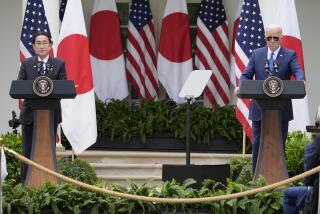Which Way for America and Japan? : To Avoid Bitter Economic Battle, They Should Seek Areas of High-Tech Cooperation
- Share via
President Reagan and Japanese Prime Minister Yasuhiro Nakasone are meeting as both inaugurate second terms in office. Despite this continuity of leadership, it is a time of flux and fragility in U.S.-Japan relations. The patron-client relationship that has typified most of the postwar period is fading fast, but it remains unclear, either in Tokyo or in Washington, what will take its place.
The relationship could easily deteriorate into an acrimonious, intensely competitive pattern with an escalating catalogue of grievances on both sides of the Pacific. The Americans’ complaints will center on Japanese trade practices, while the Japanese will feel that they are the scapegoats for American economic failures.
This is not a healthy scenario for long-term American or Japanese economic and security interests. Consequently, it is important that the two countries identify major areas where they can collaborate to mutual advantage.
One area that warrants more attention than it has received is technology. Together, Japan and the United States lead the world in most advanced areas of civilian science and technology--including microelectronics, computers, telecommunications, biotechnology, materials science and optics. Technological change has been the primary engine of past economic growth for both countries, and this will be even more true in the future.
Conventional wisdom has long viewed the Japanese as imitators and borrowers, but not creators, of technology. This view is partly valid, but it is also misleading. Japan’s spectacular economic achievements reflect a successful effort to adapt, refine and improve existing technology. That effort has been sustained by a major commitment of resources to applied research and development.
As a percentage of the total economy, research and development expenditures have risen more rapidly in Japan over the last decade than in any other major industrialized country. The United States and Japan together now account for nearly 65% of all research and development spending in the free world. (Compared to ours, Japan’s investment is primarily civilian, based in the private sector, and focused on industrial growth, particularly electronics.)
It is in basic science, the wellspring of real technological innovations and breakthroughs, that the Japanese have been second best. In November Japan’s powerful Council on Science and Technology, chaired by the prime minister, called for a new emphasis on basic scientific research. The goal is greater creativity in science and the elevation of Japan to the forefront of scientific knowledge. Behind this decision lies the fear that American sources of technology may be increasingly foreclosed to Japan as protectionist sentiment grows, plus the realization that in some areas Japan need not rely on others to take the lead in innovation.
All this reflects a basic judgment that the key to Japan’s future lies in the mastery of science and technology. The implications for U.S.-Japan relations are profound. As its capabilities in these areas expand, Japan can be an increasingly potent competitor or partner. There is much to be said for partnership: As allies, Washington and Tokyo have broadly shared political, strategic and even economic interests in the international arena. The United States can benefit from Japanese technical advances. Complementary skills and resources can be matched, and costs can be shared.
A variety of collaborative programs and projects already exist in public and private sectors: joint research, co-production and data pooling. Trends in Japan may facilitate more ambitious arrangements. The report of the Council on Science and Technology suggests opening Japanese government research facilities to foreign participation as part of a broader “internationalization” of Japanese society. Washington and Tokyo have already signed a major agreement to share defense-related technologies.
The obstacles to a more cooperative approach are formidable, including American concerns over the lack of reciprocity in current public-sector research programs. This has resulted in a largely one-way flow of scientific information--toward Japan. American companies that have developed advanced technology are often reluctant to work with the Japanese because the Japanese market is so difficult to penetrate. Such companies are also uncertain as to whether patents and licensing agreements will be adequate to protect their proprietary data from expropriation by Japanese companies.
Unless and until the defense technology sharing agreement is implemented, controls on the exporting of defense-related technologies will be a significant barrier.
A major U.S. government effort to develop collaborative arrangements with Japan in science and technology could have a substantial effect on the fabric of the bilateral relationship. It would also have implications beyond that relationship: Already, key Western European policy-makers are disturbed by the prospect of a U.S.-Japanese science and technology juggernaut that would make Europe a technological backwater. Unless European interests are taken seriously into account, any agreements between Washington and Tokyo could have a corrosive effect on the Western alliance.
Moscow has even more cause for worry. National power is increasingly defined by technological capabilities, and few prospects are more chilling for the Kremlin than a close working relationship between the United States and Japan on the most advanced technological frontiers.
More to Read
Sign up for Essential California
The most important California stories and recommendations in your inbox every morning.
You may occasionally receive promotional content from the Los Angeles Times.













